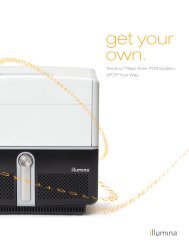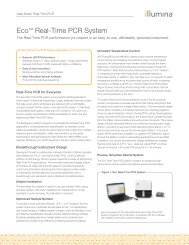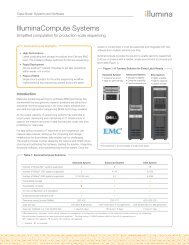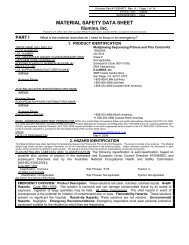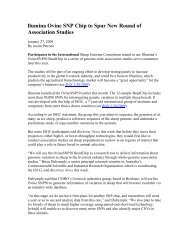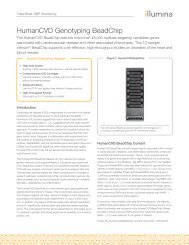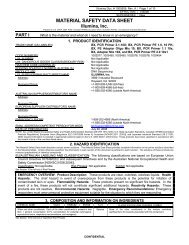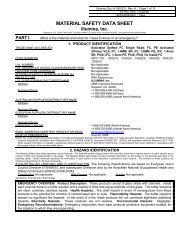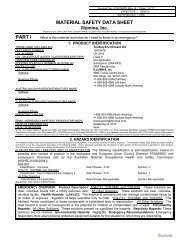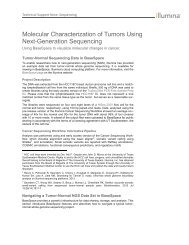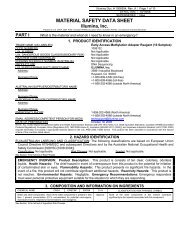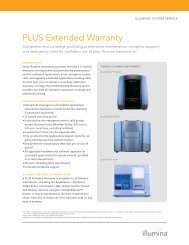MATERIAL SAFETY DATA SHEET - Illumina
MATERIAL SAFETY DATA SHEET - Illumina
MATERIAL SAFETY DATA SHEET - Illumina
You also want an ePaper? Increase the reach of your titles
YUMPU automatically turns print PDFs into web optimized ePapers that Google loves.
Infinium II Assay System Reagents <strong>Illumina</strong> Doc. # 11195131, Rev. H Page 6 of 27<br />
4. FIRST-AID MEASURES (Continued)<br />
DESCRIPTION OF FIRST AID MEASURES (continued):<br />
Eye Exposure: If this product’s components contaminate the eyes, open victim's eyes while under gently running water. Use<br />
sufficient force to open eyelids. Have the contaminated individual "roll" eyes. Minimum flushing is for 20 minutes. The<br />
contaminated individual must seek medical attention if adverse effects occur after flushing.<br />
Inhalation: If vapors, mists or sprays from this product are inhaled, remove contaminated individual to fresh air. If necessary, use<br />
artificial respiration to support vital functions. Remove or cover gross contamination to avoid exposure to rescuers. Seek<br />
medical attention if adverse effect continues after removal to fresh air.<br />
Ingestion: If this product is swallowed, CALL PHYSICIAN OR POISON CONTROL CENTER FOR MOST CURRENT<br />
INFORMATION. DO NOT INDUCE VOMITING unless directed by medical personnel. Have contaminated individual rinse<br />
mouth with water. Never induce vomiting or give diluents (milk or water) to someone who is unconscious, having convulsions, or<br />
unable to swallow. If vomiting occurs, lean patient forward or place on left side (head-down position, if possible) to maintain<br />
an open airway and prevent aspiration. If contaminated individual is convulsing, maintain an open airway and obtain<br />
immediate medical attention.<br />
IMPORTANT SYMPTOMS AND EFFECTS: See Sections 3 (Hazard Identification) and 11 (Toxicological<br />
Information).<br />
MEDICAL CONDITIONS AGGRAVATED BY EXPOSURE: Pre-existing dermatitis, other skin conditions, and<br />
respiratory conditions may be aggravated by overexposure to components of this product.<br />
RECOMMENDATIONS TO PHYSICIANS: Treat symptoms and eliminate overexposure.<br />
IMMEDIATE MEDICAL ATTENTION AND SPECIAL TREATMENT NEEDED: Treat symptoms and eliminate<br />
overexposure.<br />
5. FIRE-FIGHTING MEASURES<br />
CODE WG#-RA1 AND CODE WG#-WB1 COMPONENTS<br />
NFPA RATING<br />
FL AM MABILIT Y<br />
CODE WG#-MA1 COMPONENT<br />
NFPA RATING<br />
FL AM MABILIT Y<br />
0<br />
1<br />
HEALTH<br />
2<br />
0<br />
INSTABILITY<br />
HEALTH<br />
1<br />
0<br />
INSTABILITY<br />
OT HER<br />
FLASH POINT: Not flammable.<br />
AUTOIGNITION TEMPERATURE: Not applicable.<br />
FLAMMABLE LIMITS (in air by volume, %): Not applicable.<br />
FIRE EXTINGUISHING <strong>MATERIAL</strong>S: In the event of a fire, use suppression<br />
methods for surrounding materials (e.g., water spray, dry chemical, carbon<br />
dioxide, foam, any “ABC” class extinguisher).<br />
UNSUITABLE EXTINGUISHING MEDIA: Halon extinguishers should not be used<br />
for fires involving this product.<br />
SPECIAL FIRE AND EXPLOSION HAZARDS: Code WG#-MA1 Component: This<br />
component must be substantially preheated for ignition to become a potential<br />
hazard. When involved in a fire, this product’s components will decompose and<br />
produce irritating vapors and toxic gases (including carbon oxides, nitrogen<br />
oxides, potassium oxides, hydrogen chloride, and sodium oxides).<br />
1<br />
OT HER<br />
ALL OTHER COMPONENTS<br />
HEALTH<br />
NFPA RATING<br />
FL AM MABILIT Y<br />
0<br />
0<br />
INSTABILITY<br />
OT HER<br />
Hazard Scale: 0 = Minimal 1 = Slight 2 = Moderate<br />
3 = Serious 4 = Severe<br />
Explosion Sensitivity to Mechanical Impact: Not sensitive.<br />
Explosion Sensitivity to Static Discharge: Not sensitive.<br />
ADVICE FOR FIREFIGHTERS: Do not use halogenated extinguishing media. Move containers from fire area if it can<br />
be done without risk to personnel. Incipient fire responders should wear eye protection. Structural firefighters must<br />
wear Self-Contained Breathing Apparatus and full protective equipment. Chemical resistant clothing may be<br />
necessary. If possible, prevent runoff water from entering storm drains, bodies of water, or other environmentally<br />
sensitive areas.<br />
6. ACCIDENTAL RELEASE MEASURES<br />
PERSONAL PRECAUTIONS: In the event of a spill, clear the area and protect people. Trained personnel using<br />
pre-planned procedures should respond to uncontrolled releases. The atmosphere must have levels of components<br />
lower than those listed in Section 8, (Exposure Controls and Personal Protective Equipment) if applicable, and have<br />
at least 19.5 percent oxygen before personnel can be allowed into the area without Self-Contained Breathing<br />
Apparatus (SCBA). Monitor area and confirm levels are bellow exposure limits given in Section 8 (Exposure<br />
Controls-Personal Protection), if applicable, before non-response personnel are allowed into the spill area.




